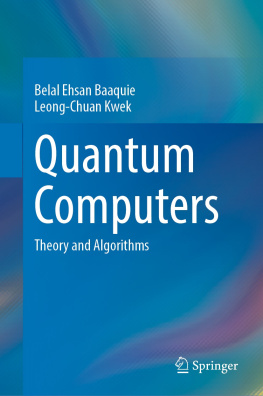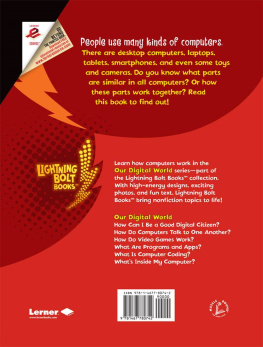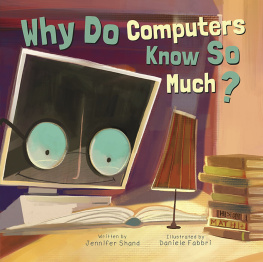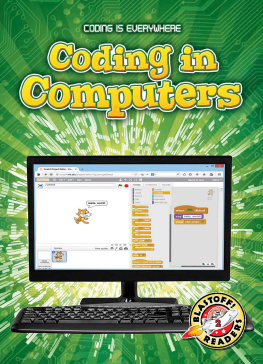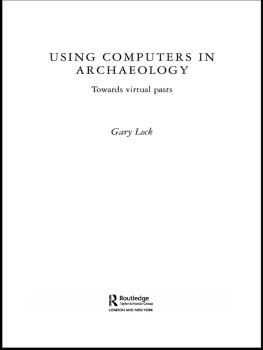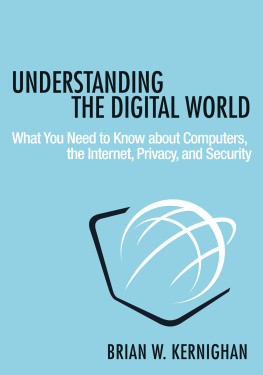BUT HOW DO IT KNOW?
The Basic Principles of Computers For Everyone
By
J. Clark Scott
Copyright 2009 by John Clark Scott
Computer design incorporated herein
Copyright 2009 by John Clark Scott
All Rights Reserved
Published by John C. Scott, Oldsmar, FL 34677
ISBN 978-0-615-30376-5
buthowdoitknow.com
Cover art, photography and design by Alexander C. Scott III artbyalexscott.com
Printed in the United States of America
First Edition : July 2009
10 9 8 7 6 5 4 3 2 1
Introduction
The title of this book is the punch line of an old joke that goes like this:
Joe is a very nice fellow, but has always been a little slow. He goes into a store where a salesman is standing on a soapbox in front of a group of people. The salesman is pitching the miracle new invention, the Thermos bottle. He is saying, "It keeps hot food hot, and cold food cold...." Joe thinks about this a minute, amazed by this new invention that is able to make a decision about which of two different things it is supposed to do depending on what kind of food you put in it. He can't contain his curiosity, he is jumping up and down, waving his arm in the air, saying "but, but, but, but..." Finally he blurts out his burning question "But how do it know?"
You may or may not have laughed at the joke, but the point is that Joe looked at what this Thermos bottle could do, and decided that it must be capable of sensing something about its contents, and then performing a heating or cooling operation accordingly. He thought it must contain a heater and a refrigerator. He had no idea of the much simpler principle on which it actually operates, which is that heat always attempts to move from a hotter area to a cooler area, and all the Thermos does is to slow down this movement. With cold contents, the outside heat is slowed on its way in, and with hot contents, the heat is slowed on its way out. The bottle doesn't have to "know" in order to fulfill its mission, and doesn't heat or cool anything. And eventually, the contents, hot or cold, do end up at room temperature. But Joe's concept of how the bottle worked was far more complicated than the truth.
So the reason for the book title, is that when it comes to computers, people look at them, see what they can do, and imagine all sorts of things that must be in these machines. Or they imagine all sorts of principles that they must be based on, and therefore what they may be capable of. People may assign human qualities to the machine. And more than a few find themselves in situations where they feel that they are embarrassing themselves, like our friend in the joke, Joe.
But computers are actually quite easy to understand. Of course computers have a greater number of parts than a Thermos bottle, but each part is extremely simple, and they all operate on a very simple, very easy to understand principle.
With the Thermos, the principle is that of the motion of heat. This is something we can observe in life. We see ice cubes melting when they are removed from the freezer, and we see the hot meal cooling off on the table when the family is late for dinner.
In the computer, the principle on which it operates has to do with electricity, but that doesn't mean that it is hard to understand. If you have observed the fact that when you turn on a light switch, a light bulb lights up, and when you turn the switch off, the light goes dark, then you have observed the principle on which computers operate. That is about all you need to know about electricity to understand computers.
Just the Facts Ma'am
This book is not primarily intended to be a textbook. There are no problems to do at the end of each chapter. Its intention is simply to demystify the subject of computers for anyone who has ever wondered what's going on inside of that box. Of course, it also makes a perfect introduction to computers for a young person who will ultimately go on to get a PhD in Computer Science. But it should be easily understandable by housewives, senior citizens and children who can read well. It should be understandable to plumbers and street sweepers. It requires no previous technical education. It only requires that you can read the language, you can turn a light bulb on and off, and you can do very simple addition on the order of 8+5=13.
This book presents the complete essentials that make up a computer. It presents every piece and part, in the proper order so that each one will make sense, and can be understood. Every part is explained fully, and every new word is defined thoroughly when it is first used. Any attempt to simplify the subject further would leave gaps in the big picture where someone would still have to guess how the parts work together, and you just wouldn't ever have that "Aha, I get it!" moment that I think you'll soon have.
This book is not a 'dumbed-down' version of some college textbook. It is a complete explanation of the basic principles of computers. It is a technical book, but so is a cookbook and so is a driver's education handbook. This book just starts at the beginning and defines every item needed to understand the machine. No matter what someone already knows about computers, this will fill in any missing pieces and put them all together into something that makes sense.
Even our friend, Joe, could understand this book with diligent study. There are thousands of words and ideas associated with the field of computers that make the whole subject seem like a mess. But the basic concepts underlying them are simple.
In this book, there will not be volumes of trivia about the construction or history of computers, just the essentials, no more and no less. Each part of the computer has a simple function, and when they are connected together, you end up with a useful machine called a computer.
There is nothing to memorize in this book. Each chapter is designed to give you a new idea that you didn't have before, or if it is something that you had heard about previously, it always seemed confusing. Each idea is very simple, and one thing leads to the next. Each chapter presents an idea. Each idea is simple and easy to understand. Later chapters present ideas that build on the ideas from previous chapters.
If someone were to write a book about how to build a house, there could be various levels of detail. The simplest book would say, "lay a foundation, put up the walls, cover with a roof, put in plumbing and electrical, and you're done." That would not be enough detail for someone who didn't already have some experience using a hammer and saw and installing a faucet and wiring a light switch.
At the other end of the spectrum would be a book that had separate chapters for every possible type of foundation, the different kinds of dirt you might have to dig in, formulas for a dozen different kinds concrete, charts of weather conditions that are optimum for laying foundations, etc. That would be far too much information. There would be so many details, that what was really important would get lost.
This book attempts to give just enough detail to see what every computer has in common and how they work, not how to build the biggest or best computer ever made. It is not about any specific brand of computer. It is not about how to use a computer. If it were a book about building a house, it would probably describe a simple plan for a sturdy garden shed with a sink and one bare light bulb, showing the size and shape of every piece of wood, where to put all the nails, how to hang the door and how to put the water pipes together so they wouldn't leak. It would not show how to build anything as complicated as a fancy curved oak staircase.
We are going to show the one simple part that computers are made of, and then connect a bunch of them together until we have built a complete computer. It is going to be a lot simpler than you ever imagined.


